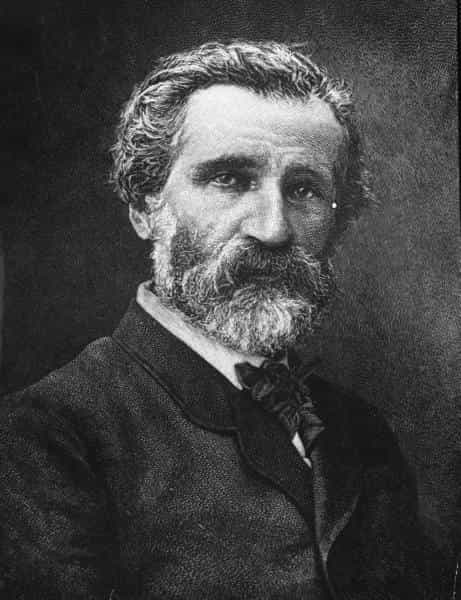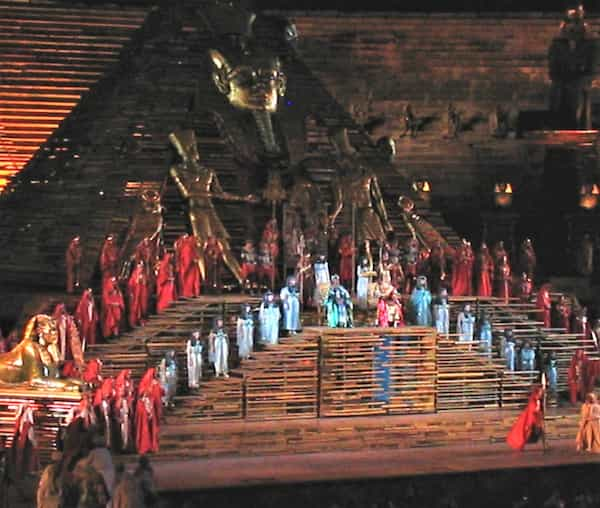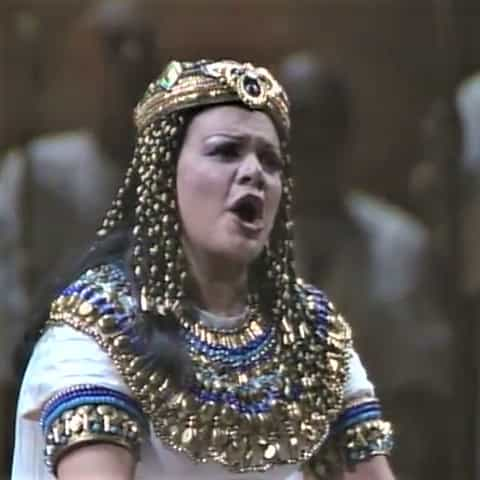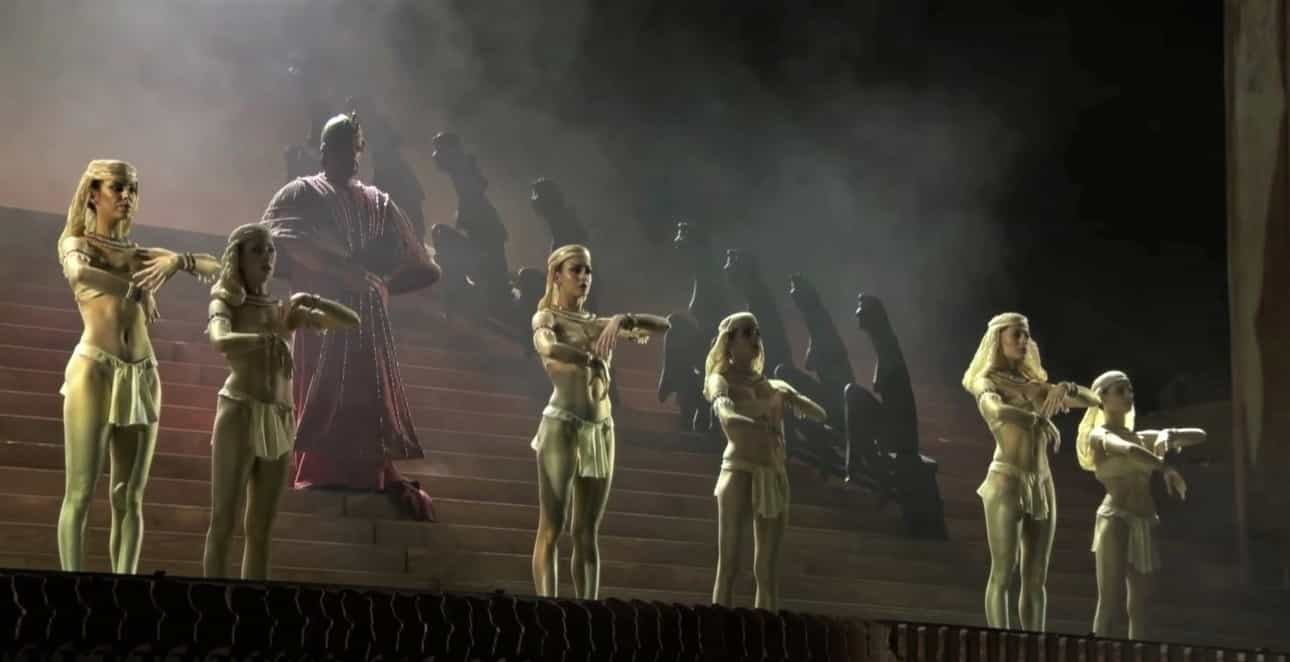Aida
Aida by Giuseppe Verdi is a grand opera set in ancient Egypt. The Ethiopian princess, Aida, enslaved in Egypt, is in love with Radamès. But Amneris, the jealous Egyptian princess wants him for herself. The opera was commissioned for the opening of Cairo’s Khedivial Opera House on December 24, 1871.
During the 1860s, Giuseppe Verdi was slowly distancing himself from composing. He worked with his estate, and he was engaged in politics.
But far away from his home in Busseto, bigger things were happening. In 1869 the brand-new Suez canal was opened. Though not a major success at once, it changed the world map overnight. And the Egyptian Capital, Cairo, suddenly became the center of the world. Verdi was asked to write a hymn for the inauguration of the canal but refused.
He was also invited by Ismāʿīl Pascià, the Khedive of Egypt, to write an opera for the inauguration of the brand new theater in Cairo… The Khedivial Opera House, inaugurated just days before the canal. He didn’t accept that either. The truth was that he didn’t really want to compose anymore. Especially if it would involve traveling far away. Verdi wasn’t fond of traveling, and he thought he had already done his share of it.
But he couldn’t escape his genius, and although he never set foot in Egypt, he finally gave up his resistance and wrote one of the most spectacular operas ever seen… Aida.

Premiere – December 24, 1871, Khedivial Opera House, Cairo, Egypt.
Composer – Giuseppe Verdi
Librettist – Antonio Ghislanzoni
Running Time – Roughly 2 1/2 hours, plus Intervals
Four Acts
Ouverture – 4 minutes
Act 1 – ca 37 minutes
Act 2 – ca 41 minutes
Act 3 – ca 33 minutes
Act 4 – ca 34 minutes
In Italian
Main characters
- Aida, Princess of Ethiopia: Lyric-Dramatic soprano (A little darker and stronger than a Lyric Soprano).
- Radamès, Captain of the Guards: Lyric-Dramatic tenor (A little darker and stronger than a Lyric Tenor).
- The King of Egypt (Pharao): Bass.
- Amneris, Princess of Egypt: Dramatic Mezzo-Soprano (…with height).
- Amonasro, King of Ethiopia, Adia’s father: Dramatic Baritone.
- Ramfis, High Priest of the Temple: Deep Bass (dramatic low bass).
Yes, as you can see, these are rather strong and dramatic voices. That’s not only because the characters need that type of sound. But it’s also because Aida is a big opera (In French, Grand operà), and it’s often played in big theaters or even outside. The orchestra is heavy, and the chorus should be sizable.
Based on an idea/outline by the French Egyptologist Auguste Mariette.
Download this short Pdf-guide. Print it, fold it, and keep it in your pocket as a help when you’re at the Opera. Please keep your phone turned off when inside the theater.
The Opera that Verdi almost never wrote…
In the 1860s, Verdi had reached a position as not only the most successful opera composer in the world, with all the fame, money, and acclaimation such a position could bring… But he was also a politically prominent individual in the new Italy founded in 1861, and completed in the following years. He was a member of the first ever Italian parliament, and later became a senator from 1874.
About his composing, he had reach every possible and impossible goal, and even though he still was very engaged and followed his operas around the continent, one can detect a slight fatigue. His last opera, Don Carlos, premiered in Paris in 1867. Before that La Forza del Destino (The Power of Fate) in 1862. The time between one opera and another, lengthened. Instead Verdi focused on his estate and Villa Sant’Agata. No different from what any extremely successful businessman in his late 50s would do.
But the French librettist and impresario, Camille Du Locle who wrote the libretto for Don Carlos, and who was also Giuseppe Verdi’s close friend, wouldn’t have it He didn’t want the undisputed Maestro of Opera-composing to just settle down and give up. He was convinced he could make him accept the offer from Cairo to write a new opera for their new opera house.
So he showed Verdi a sketch for a drama by Auguste Mariette. After having read it and reflected somewhat, Verdi gave his verdict:
– … Two or three situations, even if not new, are certainly very appealing. There is an expert hand in there, accustomed to getting things done, and who knows the theater very well.
And so, the real negotiation could start. At 150.000 franks (… If my calculations are correct, that would be around 2,5 million USD today), the contract was signed.
Background – The Opera Aida is set in…
Egypt.
The location, as the case often is with operas of with an exotic outline, is not very well specified. We are mostly in Memphis, in the King’s palace, in and around the temples, on the beach of the Nile, etc.
The second part of Act 2 is set in Thebes
But it’s not a truly realistic setting. Although Auguste Mariette was very knowledgeable in Egyptologia, Verdi definitely was not. He wanted it to be overwhelming, striking, and mysterious… Not necessarily accurate. Resistant as he was about traveling, especially at sea, he never went to Cairo to oversee the rehearsals. Instead, he wrote down instructions for every scene and almost every movement. One could easily say that Aida comes with Verdi’s directions right out of the box.
Ismāʿīl Pascià, who paid for it, wanted an “Egyptian” opera, in line with the national currents of the time. What he got was a musical masterpiece jam-packed with Egyptian and oriental details, from melodies and arrangements to clothes and props. Not all is historically precise, but it’s definitely enough to create a very ancient Egyptian feel.
The timeframe is explained by Verdi as “The time of the Pharaos”. That just tells us how aware Verdi was of the history of Egypt. “The time of the Pharaos” could mean a period from 3150 BCE to 30 BCE depending on how you define Pharao. It is usually regarded as somewhere in the third millennium BCE though.
Plot
Ouverture.
First Act, 1st part – A hall in the King’s palace, Memphis.
Ramfis, the high priest, tells Radamès that the Ethiopians are planning another attack on Egypt. He also says that the Goddess Isis already has nominated who the General of the Egyptian forces shall be.
Alone Radamès sings:
– Se quel guerier io fossi (If only I was that general…) / Celeste Aida… where he expresses his love for the slave Aida.
So, again we see how the composers like to put the singers to the test. This is not an extremely heavy or difficult aria. But it has some tricky B flats. Especially the last note should be fading and practically die out. And since the tenor has been on stage for no more than 30 seconds, it’s very easy to butcher it. The heavier voice type of Radamès could have real problems in creating a very soft diminuendo on the final high note. In that case, he would just sing it in full voice.
La Scala in Milan. Roberto Alagna, otherwise a very valid tenor, for reasons unknown finishes the aria in a less than perfect manner. In anger, he walks off stage and is substituted with Antonello Palombi fortunately hanging around, maybe to observe the competition. This happened in 2006 and since then, Alagna has not sung in an opera at La Scala.
This is how it is supposed to be done. Franco Corelli from 1962. Just close your eyes if you’re disturbed by the “silent film”-gesticulation and the fact that it’s a very obvious play-back. The voice is perfect for Radamès though.
Now there’s a short scene where Amneris insinuates her love for Radamès… Sort of… But when Aida enters, Amneris sents the attraction between the slave and Radamàs. The scene finishes with a trio, Ohimé di guerra fremère. Amneris sings:
– Oh tremble, royal slave, tremble!
Now everybody enters, ministers, priests, captains, the high priest and the King with his guards. A messenger tells them that in the south, the Egyptians have already taken a heavy blow by the Ethiopians, and the city of Thebes is threatened. Ramfis announces that Isis has chosen Radamès to conduct the Egyptians into battle.
Verdi conducts us into a huge bombastic scene where everybody sings at the top of their lungs. True Grand Operà with the unmistakable sensibility for catchy melodies:
– Su! del Nilo al sacro lido… (…Let only one cry echo: War and death to the foreigner!)
The scene ends with a very famous phrase:
– Ritorna vincitor!
All Egypt wishes for Radamès to return as a victor.
Aida stays behind and sings:
– Ritorna vincitor… L’insana parola… (Come back as a victo!… Insane words…)
and then:
– Numi, pietà del mio soffrir!
A long demanding scene where she expresses her divided loyalties. She’s in love with Radamès who’s on his way to killing her father. Here she is a slave, living only to serve, but in truth, she is a Princess, daughter of a King.
First Act, 2nd part – Inside the Vulcan temple.
Here’s a scene that is pretty typical for the Grand Operà. Radamès is conducted into the temple and given some sort of holy weapon/blessing. He is preparing for the battle and the Gods are asked to assist him.
The set is very exotic, the place is mystical, and the music has an eastern touch to it. The priestesses chanting is heard off stage. Then there’s a ballet, or at least it should be.
After that Ramfis and Radamès sing a sort of duet together with the chorus, where they invoke the Gods.
Radamès sings forte (strong voice) in his most voluminous register. If he’s hardly heard over the chorus, it’s not the right voice for the part.
It’s beautiful, but it doesn’t really carry the story forward.
Second Act, 1st part – Amneris’ chamber.

The act begins with a female chorus:
– Chi mai fra gl’inni e i plausi.
… and the famous dance of the Moorish slaves.
Radamès and the Egyptian soldiers have won the war. They crushed the Ethiopians at Thebes and took many prisoners.
When Aida enters Amneris sends away everybody. Then she tricks Aida to expose her love for Radamès. She tells her that he is dead and watches how she falls into despair. Then they sing a long duet.
– Fu la sorte dell’armi a tuoi funesta.
So, the cards are on the table. Amneris now knows about their love, and she intends to destroy Aida. She on the other hand pleas for mercy, but Amneris is furious.
Now, Aida’s situation shouldn’t be able to worsen, but as we will see further on, it can. New clouds are on the rising.
Second Act, 2nd part – The Gate to the city of Thebes.
Now we have the highlight of the evening. Radamès is entering Thebes as the undefeated general of the Egyptian army. The whole city is cheering, the King, Amneris, the priests, and the people… All are there to salute the victor. The Chorus sings:
– Gloria all’Egitto! (Glory to Egypt), with the famous triumphal march.
It is a showstopper. Verdi had a true talent for writing chorus pieces that have become independent evergreens. And this is one of those. Something that a big opera chorus throws in at the end of a recital to make an impact. Verdi had a trumpet designed especially for this scene, the so-called Aida-trumpet. He needed a bright and strong sound to contrast the huge orchestra and chorus that surrounds the triumphal march, before and after. These trumpets should be played on stage proceeding the troops.
Now a few important things happen.
- The King deems that Radamès shall be granted anything he wishes.
- The Ethiopian slaves are brought before the King. Among them is Amonasro, Aida’s father.
- She recognizes him but is silenced by him. He then proclaims that the Ethiopian King (…himself) is fallen, and sings defiantly:
– Quest assisa chio vesta vi dica… (… If love for our country is a crime
we are all guilty)
Just like with Radamès, Amonasro actually sings only six words before his only real aria. It’s short but challenging, and you need to keep your nerves in check.
The priests and the people do not agree on what to do with the prisoners. Kill them or spare them. So, Radamès steps up and claims the prize, the one wish that the King had promised him.
– … For the Ethiopian prisoners, I ask life and freedom.
The high priest, Ramfis, proposes a compromise… Set them all free except for Aida and her father. And with that, the King of Egypt declares that Radamès shall be his successor and that he will have Amneris’ hand in marriage. Everybody’s good, but Aida has taken another blow. Now, not only does she have to stay a slave, but her father is a prisoner too. Amneris has taken Radamès from her and Amneris has all the power in the known world to get back at her. Dark times lie ahead…
Third Act – The shores of the Nile.
There’s a very short but interesting intro with the strings playing one chord very rhythmically, and violas playing pizzicato (plucked). A solo flute plays a beautiful oriental tune.
Amneris says she’s going to pray to Isis for Radamès to love her. She enters the temple together with Ramfis.
At the shores of the Nile, Aida is seen alone, waiting for Radamès. She sings:
– Qui Radamès verrà… Che vorrà dirmi? / O patria mia… (Radamès will come… What will he say? / O my homeland…)
This is Aida’s moment of glory. A solo oboe plays an ingeniously mastered legato line sending your thoughts straight into the desert night. O patria mia starts at an F5, very soft… A crescendo and then a diminuendo. It’s difficult for a dramatic voice like Aida, and again we see that many parts on the opera stage actually would need to be incredibly flexible. If you’re fortunate enough to have a really good soprano, this can be a memory for life.
She has already decided to let the river embrace her. She has lost her one and only love, she will never see her motherland again, and she is fully subdued to a woman who hates her and wants nothing else than to wipe her off the face of the earth. Her life is over…
But instead of Radamès, Amonasro, her father, shows up. The two have a very dramatic scene:
– O ciel! Mio Padre! / Rivedro le forest imbalsamate…
Amneris has all his freed troops ready. Now all he needs is information about where Radamès is conducting his army, and he will ambush him. So he starts working with Aida. It’s a cruel game, but when he shouts:
– You’re not my daughter anymore. You are an Egyptian slave…
she can’t resist the pressure. Amneris hides to be able to eavesdrop on the Captain. Radamès arrives.
The two lovers meet once again. Aida says Radamès can’t escape the marriage with Amneris. Radamès on the other hand declares that he still loves Aida. Together they decide to run away but before they get so far they sing for ten minutes straight. Finally Radamès says when asked about the route they should follow to avoid any troops:
– We will take the path chosen by ours to fall upon the enemy… Nàpata. It will be deserted until tomorrow…
At that, Amonasro jumps out of his hiding place and reveals his true identity. After that things happen fast.
- Radamès is desolated to have betrayed his country, his honor, and his King.
- Aida tries to make him run away with them and succeeds after some heavy singing by all three.
- When they are about to leave, Amneris and Ramfis come out from the temple.
- Amonasro tries to kill Amneris with a knife, but he’s obstructed by Radamès.
- Then Radamès tells Amonasro and Aida to flee.
- Radamès surrenders to the imperial guards.
Fourth act, 1st part – We are back in the King’s palace, Memphis.
Amneris is torn between her feelings of jealousy and betrayal after knowing the Radamès was going to run away with the slave girl, and her still very strong love for him. Treason is a crime that calls for the most severe punishment. She will try to save him and calls for the guards to bring him to her.

Now follows a long and very dramatic duet between Amneris and Radamès. Amneris offers him salvation if he just declares his innocence in front of the judges. But Radamès is ready to die. Just like Aida in the previous act, he doesn’t care to live since he believes his one true love is dead.
But Amneris tells him that while the guards killed Amonasro, Aida is alive, and she escaped. And she changes tactics somewhat and asks him to swear to not see her again. He refuses.
This can be a very good seven minutes. But if the singers are not real champions, it could also come out as a screaming contest. Just relax and wait, it will get better…
Amneris sings:
– Ohime!..morir mi sento. (Now, I curse you, atrocious jealousy… I myself gave you away…)
This is another tricky piece. Short and not difficult at all. It’s just that it is very low. Sometimes a dramatic mezzo-soprano doesn’t have a good, full voice in the lower register, especially if she needs good heights elsewhere.
The guards bring Radamès to be judged by Ramfis and the priests. The tribunal should be held off stage while we continue to watch Amneris in agony. Radamès continues to not open his mouth and is sentenced, as a traitor, to be buried alive. When the priests and Ramfis return, Amneris is furious. As a last effort, she curses them all and says that he is innocent and that she loves him. She accuses the priests:
– Unholy race! Heaven’s vengeance will descend on you!
Fourth Act, 2nd part – The underground of the temple.
Radamès is walled in and ready to die. His only regret is that he will not see Aida again. Suddenly there’s a movement in the shadows. A figure slowly approaches, and of course, it’s Aida. She had sneaked into the tomb earlier to be able to die together with Radamès. Aidas short melody:
– Vedi?… di morte l’angelo. (can you see it?… The angel of death)
is another highlight. From the background, we hear the chorus chanting the death hymn. With the last duet:
– O terra, addio; addio, valle di pianti… (World, goodbye… Goodbye, valleys of tears…)
the two devoted lovers approach the eternal shores. Verdi is precise about the scene. It should be divided into an upper part, the temple, and a lower part, the underground.
The very last words are Amneris’ praying inside the temple over the dying couple:
– Peace I implore you, holy martyr… Eternal sorrow awaits me…
Things to look out for.
First act
1 minute – Celeste Aida, Radamès first and very delicate aria.
6 minutes – Aida enters and there should be a strong tension between her and Radamès
13 minutes – Su del Nilo… It should be compelling. At the end of the ensemble, there’s the phrase Ritorna Vincitor!… first by Amneris, then by everybody.
Immediately after there’s the long solo scene with Aida in anguish.
25 minutes – The second part of the Act starts. Listen to the voice and the chorus off stage accompanied by a solo harp.
33 minutes – Can you even hear Radamès?
Second act
3 minutes – Dance of the Moorish slaves.
16 minutes – Gloria all’Egitto!
19 minutes – The Triumphal march.
31 minutes – Quest assisa chio vesta vi dica… Amonasro’s only aria.
39 minutes – Radamès asks for freedom for the prisoners.
Third act
0 minutes – At the opening, listen to the strings and the short flute melody.
5 minutes – O patria mia, Aida’s most famous aria.
30 minutes – Amonasro jumps out from his hiding place and from there everything happens fast.
Fourth act
10 minutes – Ohime!..morir mi sento. Amneris short aria.
15 minutes – The tribunal is held off stage.
29 minutes – O terra, addio; addio, valle di pianti… Aida’s and Radamès’ last duet.
About Aida.
The concept Grand Operà was dying in the 1870s. In Paris the public still loved it but elsewhere new trends were emerging. Even though many experts do not necessarily regard Aida as an example of Grand Operà I would definitely call it Grand – Big. Huge in fact.
After all, definitions are just what historians decide to agree upon. Aida was and is a huge enterprise. It’s difficult and costly. The orchestra is big, and so is the chorus (The second act actually would require three choruses… ). The singers around today who can do the difficult parts justice are few and expensive. And the scenography is often elaborated. Therefore it’s so spectacular that it is so popular. It is among the 10 most played operas in the world. Many times extraordinary efforts have been made to transport whole theater productions to Egypt and play in the open in front of the real pyramids. It is big, no doubt about it.
As Verdi never went to Egypt, he always regarded the real premier as the one in Italy. On February 8, 1872, La Scala in Milan opened their doors for Aida. It was just as much a success as it had been in Cairo. And from there the opera immediately conquered the world, with premiers in all the world’s major theatres in the following decade.
Warning!
And now my own personal reflection. People sometimes ask if Aida is a good first-time opera…
No, it is not! And I will explain why:
Those who have never actually seen an opera, sometimes have preconceptions. Opera is just a bunch of fat men and women in Viking clothes, screaming at the top of their lungs, and still, you can’t hear a word they’re saying.
Aida is a stationary opera. The action isn’t built into the acting by the singers, but rather into the big and extravagant scenography, the clothes, and the vocal and musical impact. Although love is an eternal topic, and so is national hostility, politics, and war, this story, set so far back in time, can seem a little bit too abstract for a first-time listener.
Sometimes the makeup doesn’t do anything to help. Strange lines around the eyes, and even worse, white people colored brown with body makeup, to look Ethiopian. It is a delicate act of balance.
You could be lucky, and find yourself among super professionals, giving you an experience of a lifetime. But if you’re not, there’s a risk that the presumptuous newcomer will just get his presumptions confirmed. I have seen too many Aidas coming out just like “A bunch of fat men and women screaming at the top of their lungs, and still, you can’t hear a word they’re saying.” It’s just the Viking clothes that are missing.
Yet, if the crew is of the right stuff, Aida is one of those operas that can leave you breathless. I believe you would have to have some experience with the special opera language of the 1800s, though. Otherwise, the bet is bigger than the win. You should absolutely see it if you get the chance, but maybe not as a first-timer.
Download this short Pdf-guide. Print it, fold it, and keep it in your pocket as a help when you’re at the Opera. Please keep your phone turned off when inside the theater.

